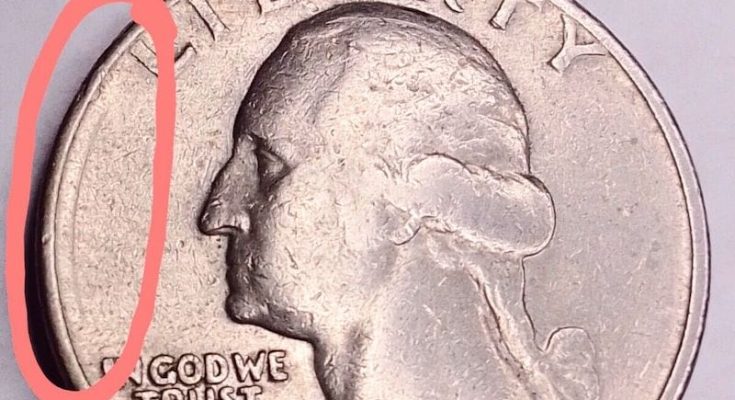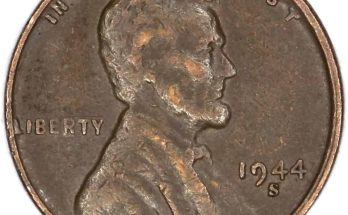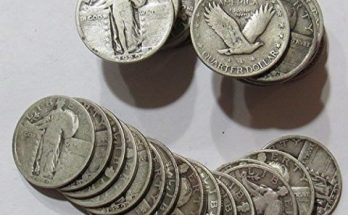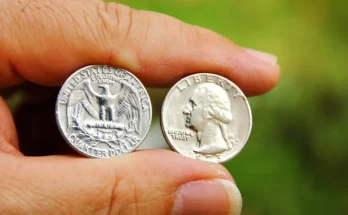The 1967 Quarter Design & Composition
The Obverse Side of the 1967 Quarter
On the obverse side of the 1967 quarter, you’ll find a left-facing portrait of George Washington, the esteemed Founding Father and first President of the United States. His hair is neatly tied back in a low ponytail, and his gaze is resolute as he looks straight ahead.
Above Washington’s head, the word “LIBERTY” is elegantly inscribed, and just below him, the year “1967” is prominently displayed. To the left of the coin, you’ll notice the national motto, “IN GOD WE TRUST.”
The Reverse Side of the 1967 Quarter
The reverse side of the 1967 quarter boasts one of the most distinguished and visually captivating designs in American coinage. It showcases a regal eagle with its wings outstretched, perched upon a bundle of arrows and olive branches. The arrows symbolize preparedness for war, while the olive branch represents peace.
At the top of the eagle’s head, the U.S. motto “ET PLURIBUS UNUM” is featured, meaning “out of many, one,” symbolizing the unity of the states. Above this motto, you’ll find the words “UNITED STATES OF AMERICA,” and below the eagle, the coin’s denomination is clearly marked as “QUARTER DOLLAR.”
Where is the mint mark on a 1967 quarter?
It’s important to note that no mint marks are on any of the quarters minted in 1967. During the years 1965 to 1967, the U.S. Mint intentionally ceased the use of mint marks as a measure to discourage coin hoarding. Collectors would often keep coins from specific mint branches that produced fewer coins of a particular denomination in a given year, creating a scarcity of certain coins and causing a coin shortage. The U.S. Mint temporarily eliminated mint marks from its coins to address this issue.
The 1967 Quarter Composition & Dimensions
A quarter from 1967 typically weighs 5.67 grams (0.2 ounces) and is 24.3 millimeters (0.9 inches) in diameter. Remember that some of these dimensions can change over time due to excessive circulation, so if your coin is slightly lighter or smaller, it doesn’t necessarily mean it is not authentic.
The quarters minted in 1967 comprise 91.67% copper and 8.33% nickel. The 25-cent coins were made of silver from their inception to 1965, when the Mint decided to change the composition.
The 1967 Silver Quarter
It’s important to note that the 1967 quarter does not contain any silver content. The use of silver in quarters had actually come to an end several years prior. In 1965, due to rising silver prices and the economic considerations of the time, the United States Mint ceased the production of silver quarters and shifted to a composition of copper and nickel, which is the standard alloy used for quarters today. Therefore, any silver quarters you encounter from 1967 onward would be a rarity, as they no longer contained silver.
The 1967 Quarter Value
A 1967 Washington quarter is usually worth $0.25 to $10, but rare minting errors or pristine conditions can make it worth thousands. The highest recorded sale for a 1967 quarter reached $8,812 in 2017, with minting errors and condition being key value determinants.
1967 Washington Quarter Value Chart
| Condition | 1967 Washington Quarter |
| Good | $0.25 |
| Fine | $0.25 – $1 |
| About uncirculated | $1 – $5 |
| Uncirculated | $5 – $10 |
| Mint state (65+) | $10 – $8 000+ |
1967 Quarter Worth $35,000
The most expensive quarter from 1967 was sold for $8,812 in 2017 at Heritage Auctions. A quarter from 1970, on the other hand, sold for a whopping $35 000 recently! It was accidentally struck on a Canadian quarter from 1941, making it one-of-a-kind.
1967 Quarter No Mint Mark Value Determination
In 1967, the US Mint produced an astounding 1,524,031,848 quarters, with coins minted in three locations: Philadelphia, Denver, and San Francisco. However, identifying the origin of your coin becomes challenging due to the absence of mint marks during the years 1965 to 1967. Instead of being marked by their mint, the value of these quarters is determined by factors such as their condition, rarity, and potential mint errors, deviating from the typical reliance on mint marks for identification.
The 1967 Quarter Errors & Associated Values
The coin minting process is a highly intricate one, involving numerous machines and skilled individuals at every stage. With the US Mint churning out over 10 billion coins annually, the inevitability of errors adds an element of rarity and intrigue that captivates collectors. Let’s explore some of the most prevalent and enticing errors that can be found in the 1967 quarter and other coins.
Doubled Die Errors
Among the most coveted errors in the world of coin collecting is the doubled die error, which occurs when the coin die inadvertently imprints a slightly offset duplicate image on the coin’s surface. Examine the coin’s lettering and features closely to detect any signs of doubling.
Identifying doubling on a coin is often a subtle task, as it can manifest on both the obverse and reverse sides. If you’re uncertain about whether your coin exhibits a doubled die error, seeking guidance from a professional coin-grading service like PGS or NGC is a wise course of action.
This type of error can significantly impact the coin’s value. In the case of the 1967 quarter, double-die coins can be found in the market for prices ranging from a few dollars to over $1000, making them a fascinating and potentially valuable addition to any collection.
Off-Center Strikes
Off-center strikes represent a distinctive type of coin error, occurring when a coin is minted with part of the design missing or cut off due to misalignment during the striking process. The extent of the off-center strike can significantly enhance the coin’s overall value.
What makes these off-center coins truly intriguing is their increased value compared to their standard counterparts and their fascination with collectors. Detecting an off-center error can sometimes be challenging, especially when the misalignment is subtle. Therefore, it is advisable to thoroughly examine your coin specimen before making any decisions to spend or sell it.
In the case of 1967 quarters, the presence of an off-center error can elevate their worth by tens to hundreds of dollars. The coin’s condition, in addition to the severity of the minting error, plays a pivotal role in determining its value.
Clipped Planchets
Sometimes, a piece of metal is clipped off the coin blank, or “planchet,” before it’s struck. This results in a coin that’s missing a piece of its edge.

Although very entertaining to come across, the quarters from 1967 with clipped planchet are not as valuable as some of the other errored coins we mention in this article. They are usually priced at $1 – $20 on average.
Die Cracks
A die crack occurs when the die used to mint the coin develops a crack, resulting in a raised line on the actual coin. These can be small or quite noticeable.
Die cracks usually don’t significantly raise the price of a 1967 quarter. Most are sold on the open market for only several dollars, with some rare instances when they are priced at $5 – $20. The exceptions are coins that contain several different mint errors apart from die cracks.
Cuds: A Noteworthy Minting Error
Cuds represent a distinctive error in coin production, bearing similarity to die cracks but distinguished by their greater extent. This type of error occurs when a portion of the coin die breaks away, resulting in a coin with an unstruck, blob-like area.
Cuds are seldom solitary anomalies; coins afflicted by this error often exhibit various other minting imperfections. Consequently, these error-laden coins command a higher value compared to their standard counterparts. Quarters minted in 1967 that display cud errors can be found on the market with price tags ranging from a few dollars to several hundred dollars. Determining the exact value of such a coin can be challenging for those not well-versed in numismatics or without professional expertise.
Overstrike or Double Strike
This occurs when a coin isn’t ejected properly and struck more than once but not precisely over the original imprint.
The double-struck coins are more interesting when paired with other errors, such as the off-center error in the picture above. They are worth $5 to $50 more than the regular coins on average, in the case of a quarter from 1967.
Wrong Planchet Errors
Although rare, a 1967 quarter could sometimes be struck on a planchet intended for a different coin altogether.
Numerous occurrences exist of 1967 quarters being struck on the incorrect planchets.
Consider this MS64-grade quarter, struck on a planchet originally meant for a penny, currently available for sale at a price of $1,850:
Struck-Through Errors: Unusual Impressions
Struck-through errors occur when an external object intrudes between the coin and the die during the striking process, imprinting that object on the coin’s surface.

You can find 1967 quarters with struck-through errors available online, with prices ranging from as low as $1.99 to as high as $325. The value primarily hinges on the coin’s condition, so if your struck-through specimen remains in mint state, you stand a better chance of fetching a substantial sum when selling it.
Consider Adding a 1967 Quarter to Your Collection
A 1967 quarter is a worthy addition to your coin collection. Notably, none of the quarters minted in 1967 feature mint marks, rendering all of them equally valuable.
When searching for coins to purchase, it’s advisable to seek professionally graded specimens. The same principle applies if you intend to sell your coin – authentication is key to determining its true market value.
Keep an eye out for intriguing errors such as off-center strikes, double dies, or coins struck on the wrong planchet. These errors can significantly enhance the value of your coins, including any 1967 quarters in your possession.
Best of luck on your numismatic journey, whether you’re just starting out or an experienced collector!



